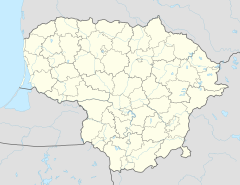Kailis forced labor camp
| Kailis forced labor camp | |
|---|---|
 Former building of the camp in 2001 | |
| Location | Ševčenkos street 16,Vilnius,Lithuania 54°40′35″N25°15′59″E/ 54.67639°N 25.26639°E |
| Date | 5 October 1941 to 3 July 1944 |
| Incident type | Forced labor, imprisonment, mass shootings |
| Organizations | Nazi SS |
| Ghetto | Vilna Ghetto |
| Victims | About 1,000 Jews |
Kailis forced labor camp(kailisis Lithuanian forfur) was a Nazi labor camp for Jews inVilnius(pre-warSecond Polish Republic,post-warLithuanian SSR) duringWorld War II.It was based on a pre-war fur and leather factory and mostly produced winter clothing for the German military. At its peak, after the liquidation of theVilna Ghettoin September 1943, the camp housed about 1,500 Jews. The camp was liquidated and its workers executed atPonaryon 3 July 1944, just ten days beforeRed Armycaptured the city.
Establishment
[edit]There were several fur and leather workshops and factories in Vilnius, most of them owned by Jews. After theSoviet occupationin June 1940, private enterprises werenationalized.The three fur factories Furs, Nutria,[a]and Ursus were consolidated and merged into one fur factory.[2]One factory was located behind theVilnius Town Hall.[b]Almost immediately after theGerman invasion of Russiain June 1941, the factory was given orders to produce winter clothing for theWehrmacht.[5]Its director took measures to protect factory workers who were mostly Jewish from the atrocities committed in theVilna GhettoandPonary massacre.For example, on 9 September, the director successfully petitioned the German administration to dedicate four houses within the ghetto to workers of Kailis.[5]
On 5 October 1941, the factory was moved to the larger premises of the evacuated radio receiver factoryElektrit.[c]The move was arranged by Oscar Glik, an Austrian Jew who managed to obtainVolksdeutschepapers and later, in effect, became director of the factory.[7]At the time, the factory had 448 workers. Together with family members (a total of about 800–1,000 people), they lived in two large buildings at the factory site.[d][5]It was a relatively safe place; the workers were one of the first to receive work permits (known asyellow Schein) that protected them fromAktions– round ups for executions atPonary.[7]Ghetto inhabitants considered Kailis workers as "privileged" and resented them.[8]
The "quiet period"
[edit]
On 18 January 1942, the factory suffered a major fire.[7]The cause is not entirely clear. According toAbraham Sutzkever,it was a sabotage action byFareinigte Partizaner Organizacje(FPO), but Isaak Kowalski stated that it was an accident.[5]During the investigation, Germans discovered that Glik was a Jew and executed him and his wife.[7]
In May 1942, Germans conducted a census in theGeneralbezirk Litauenof theReichskommissariat Ostland.The census counted 1,016 people from 348 families at Kailis.[5]1942 was the "quiet period" which provided an opportunity to establish some cultural life at the camp. The Jews established a school for children, a small library, sports competitions. The camp had its own Jewish police and clinic.[5]
Liquidation
[edit]In August–September 1943, Vilna Ghetto was liquidated and only the Kailis andHKP 562 forced labor campsand two other small groups[e]remained in the city.[5]The population of Kailis swelled up. Many Jews used the camp as a temporary refuge before finding a better hideout or joining theJewish partisansin the forests. According toYitzhak Arad,about 600 Jews passed through the camp.[8]On 15 October,Bruno Kittelconducted a thorough inspection of the camp and executed about 30 Jews who could not account for their presence at the camp. The inspections were carried out a few more times.[7]In November, Kailis received a new commander, SS-man Richter. He instituted a greater control of the camp and compiled a list of its residents. The list contained about 1,350 names, though another 100 or so were too afraid to register.[5]
On 27 March 1944, the camp's children under age 16 were rounded up in an operation commanded byMartin Weiss.They were taken to the train station; their further fate is not known.[7]Without a concrete evidence of their fate, various rumors spread. TheBlack Bookpublished a testimony that the children were taken toKrakówwhere they were used as blood and skin donors for injured German soldiers.[9]On 20 April, 80 workers from Kailis were taken to Ponary to exhume and burn corpses according to theSonderaktion 1005.On 3 July 1944, remaining workers of Kailis were rounded up, transported to Ponary, and executed. In total, about 2,000–2,500 Jews from various camps were executed in Ponary that day.[7]
Notes
[edit]- ^Nutria was located in Paupys district (present-day Paupio street 28).[1]
- ^The building is located on the corner of Didžioji st. and Etmonų st. Before 2011, it had a dual address of Didžioji st. 29 and Etmonų st. 1.[3]In Polish, the street was known asulica Hetmańska.[4]
- ^Elektrit was located at present-day Ševčenkos street. In 1941, it wasMortos Mindaugienėsstreet.[5]Before that it was named after GeneralStanisław Szeptycki(ulica Generała Szeptyckiego).[6]
- ^The two blocks were at M. Mindaugienės st. 7/8 and M. Mindaugienės st. 15.[5]
- ^The first was about 70 Jewish working at a military hospital inAntakalnisand the second was about 60 Jews working for the Gestapo.[5]
References
[edit]- ^"Istorija"(in Lithuanian). AB "Vilniaus kailiai". 2010. Archived fromthe originalon 3 February 2003.
- ^Žiugžda, Juozas (1972).Vilniaus miesto istorija nuo Spalio revoliucijos iki dabartinių dienų(in Lithuanian). Mintis. p. 130.OCLC551459086.
- ^"Dėl adresų (Panevėžio g. 14/a. Jaroševičiaus g. 22 ir kt.) keitimo Vilniaus miesto savivaldybėje, Naujininkų seniūnijoje. Įsakymas Nr. A30-120"(in Lithuanian). Vilnius City Municipality. 25 January 2011.Retrieved1 July2017.
- ^Shevelev, Igor (2007).Улицы Вильнюса.О Вильнюсе(in Russian). Archived fromthe originalon 4 May 2008.Retrieved1 July2017.
- ^abcdefghijkGuzenberg, Irina (2 July 2008)."Vilniaus geto darbo stovyklos ir 1942 m. gyventojų surašymas"(in Lithuanian). The Vilna Gaon Jewish State Museum.Retrieved1 July2017.
- ^Regelskis, Dalius (3 March 2015)."Slaptos T. Ševčenkos loftų istorijos"(in Lithuanian). Mano namai.Retrieved1 July2017.
- ^abcdefgBubnys, Arūnas (2011). "Vilniaus žydų žudynės ir Vilniaus getas".Holokaustas Lietuvoje 1941-1944 m.(in Lithuanian). Lietuvos gyventojų genocido ir rezistencijos tyrimų centras. pp. 41–42.ISBN978-609-8037-13-5.
- ^abArad, Yitshak (1980).Ghetto in Flames: The Struggle and Destruction of the Jews in Vilna in the Holocaust.Jerusalem: Yad Vashem Martyrs' and Heroes' Remembrance Authority. pp. 158, 443.OCLC499443649.
- ^Ehrenburg, Ilya; Grossman, Vasily (2009). Patterson, David (ed.).The Complete Black Book of Russian Jewry(4th ed.). Transaction Publishers. p. 257.ISBN978-0-7658-0543-0.

